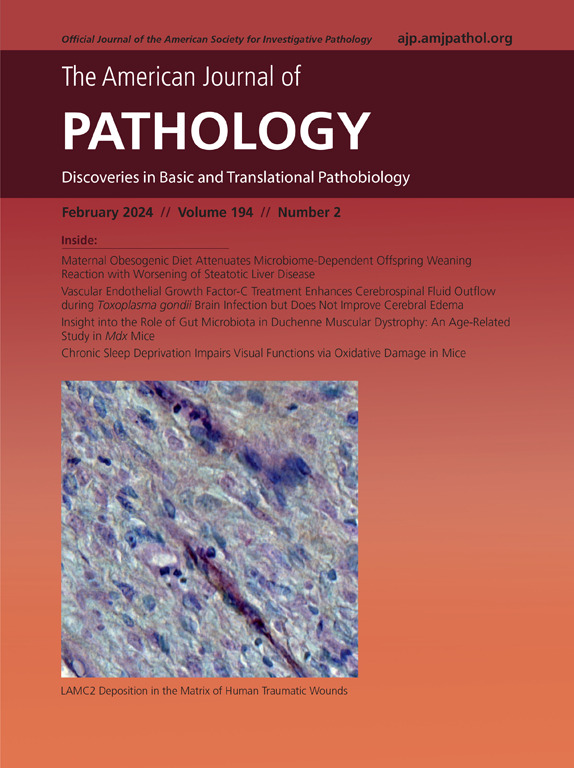Multimodal Diagnostic Imaging of Metabolic Dysfunction–Associated Steatotic Liver Disease
IF 4.7
2区 医学
Q1 PATHOLOGY
引用次数: 0
Abstract
Chronic diseases of the liver are major public health concerns worldwide. Steatosis and steatohepatitis associated with alcoholic liver disease, metabolic dysfunction–associated fatty liver disease/nonalcoholic fatty liver disease, and hepatitis B and C contribute to chronic diseases of the liver. Liver fibrosis occurs in all forms of advanced chronic diseases of the liver, the confirmation of which is typically performed by needle biopsy. Imaging approaches for liver diagnosis exist but do not provide sufficient diagnostic accuracy for defining the various stages of fibrosis or steatosis. Therefore, there is a need for improved imaging capabilities to enhance disease diagnosis. Ultrasonography-based photoacoustic imaging has recently emerged as a noninvasive, nonionizing modality, capable of capturing structural details and oxygen saturation changes during disease progression. However, its potential for detecting surrogate metabolic dysfunction–associated fatty liver disease markers, such as collagen and lipids, which are often poorly resolved by other conventional imaging techniques, has yet to be investigated in detail. The novelty of this study lies in the innovative use of spectral photoacoustic imaging for the direct detection and quantification of key biomarkers of liver disease, such as fibrosis, collagen, lipids, and oxygenated and deoxygenated hemoglobin, in a mouse model of steatotic fatty liver disease. Ultrasonography-based photoacoustic imaging, validated with magnetic resonance imaging, effectively identified increases in liver adiposity and fibrosis, enabling the noninvasive detection of changes in liver pathology associated with metabolic dysfunction.

代谢功能障碍相关脂肪变性肝病的多模式诊断成像:光声超声和MRI的无创分析。
慢性肝病(CLD)是世界范围内主要的公共卫生问题。酒精性肝病(ALD)相关的脂肪变性和脂肪性肝炎、代谢功能障碍相关的脂肪性肝病(MASLD)/非酒精性脂肪性肝病(NAFLD)以及乙型和丙型肝炎可导致CLD。肝纤维化发生于所有形式的晚期CLD,通常通过穿刺活检进行确认。影像学方法用于肝脏诊断,但不能提供足够的诊断准确性来定义纤维化或脂肪变性的各个阶段。因此,有必要提高成像能力,以加强疾病诊断。基于超声的光声成像(US-PAI)最近作为一种非侵入性、非电离的方式出现,能够捕捉疾病进展过程中的结构细节和氧饱和度变化。然而,它在检测替代MASLD标记物(如胶原蛋白和脂质)方面的潜力尚未得到详细的研究,而其他传统成像技术往往不能很好地解决这些问题。本研究的新颖之处在于,在脂肪变性脂肪肝小鼠模型中,创新地使用光谱光声成像直接检测和定量肝脏疾病的关键生物标志物,如纤维化、胶原蛋白、脂质、氧合和脱氧血红蛋白。我们证实,经MRI验证的US-PAI有效地识别了肝脏脂肪和纤维化的增加,从而实现了与代谢功能障碍相关的肝脏病理变化的无创检测。
本文章由计算机程序翻译,如有差异,请以英文原文为准。
求助全文
约1分钟内获得全文
求助全文
来源期刊
CiteScore
11.40
自引率
0.00%
发文量
178
审稿时长
30 days
期刊介绍:
The American Journal of Pathology, official journal of the American Society for Investigative Pathology, published by Elsevier, Inc., seeks high-quality original research reports, reviews, and commentaries related to the molecular and cellular basis of disease. The editors will consider basic, translational, and clinical investigations that directly address mechanisms of pathogenesis or provide a foundation for future mechanistic inquiries. Examples of such foundational investigations include data mining, identification of biomarkers, molecular pathology, and discovery research. Foundational studies that incorporate deep learning and artificial intelligence are also welcome. High priority is given to studies of human disease and relevant experimental models using molecular, cellular, and organismal approaches.

 求助内容:
求助内容: 应助结果提醒方式:
应助结果提醒方式:


